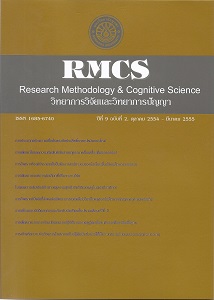การพัฒนาเกณฑ์การคัดเลือกที่ปรึกษางานวิจัย
Main Article Content
Abstract
การวิจัยนี้มีวัตถุประสงค์เพื่อพัฒนาเกณฑ์การคัดเลือกที่ปรึกษางานวิจัย นําเกณฑ์การคัดเลือกที่ปรึกษางานวิจัยที่พัฒนาขึ้น ไปทดลองใช้กับข้อมูลจริงในการคัดเลือกที่งานวิจัยของหน่วยงาน และเปรียบเทียบวิธีการให้คะแนนระหว่าง Weighted Sum Model กับ Fuzzy Set Logic Model ตรวจสอบความเหมาะสมของเกณฑ์ที่พัฒนาขึ้นโดยวิธีความเห็นของผู้เชี่ยวชาญจำนวน 17 คน เครื่องมือ ที่ใช้ในการวิจัยเป็นแบบสัมภาษณ์กึ่งโครงสร้าง และแบบสอบถามความเหมาะสมของเกณฑ์การคัดเลือกที่ปรึกษางานวิจัย ข้อมูลเชิงปริมาณ วิเคราะห์ด้วยค่ามัธยฐาน และพิสัยควอไทล์ส่วนข้อมูลเชิงคุณภาพใช้วิธีการวิเคราะห์เนื้อหา
ผลการวิจัยปรากฏว่า เกณฑ์การคัดเลือกที่ปรึกษางานวิจัยที่พัฒนาขึ้นมีองค์ประกอบ 5 ด้าน ได้แก่ ความสามารถทางการวิจัย ความสามารถในการเป็นที่ปรึกษางานวิจัย การบริหารงานวิจัยทีมงานที่ปรึกษางานวิจัย และจรรยาบรรณที่ปรึกษางานวิจัยซึ่งประกอบด้วย เกณฑ์ย่อยจํานวน 43 รายการ ผลการนําเกณฑ์ไปทดลองใช้กับหน่วยงานของรัฐแห่งหนึ่ง ชี้ให้เห็นว่า เกณฑ์ที่พัฒนาขึ้นสามารถใช้ในการ คัดเลือกบริษัทที่ปรึกษางานวิจัยได้ตรงกับผลการคัดเลือกของหน่วยงาน การให้ค่านํ้าหนักองค์ประกอบและเกณฑ์ย่อยโดยวิธี Weighted Sum Model และ Fuzzy Set Logic Model ให้ผลการคัดเลือกบริษัทที่ปรึกษางานวิจัยตรงกัน แต่วิธี Fuzzy Set Logic Model สามารถ จําแนกความแตกต่างได้ชัดเจนกว่า และผู้คัดเลือกมีความเป็นอิสระในการกําหนดค่านํ้าหนักได้ดีกว่าวิธี Weighted Sum Model
The Development of Criteria for Selecting Research Consultants
Prawit Thongchai, Suchada Kornpetpanee and Supim Sripunvoraskul
Centre for Advanced Statistical Analysis College of Research Methodology and Cognitive Science, Burapha University, Thailand
The objectives of this research were to develop criteria for selecting research consultants, to apply the criteria in an actual government offi ce, and to compare scoring from two analysis models: the Weighted Sum Model and the Fuzzy Set Logic Model. Selection criteria were examined by seventeen experts. Research instruments included a semi-structured interview and a questionnaire. Data were analyzed by median and inter-quartile range for quantitative data, and by content analysis for qualitative data.
Results indicated that the selection criteria consisted of fi ve components: research performance profi ciency, research consultant competency, research administration, research consultant teams, and research consultant ethics. There were forty-three items in the fi ve components. Applying the developed criteria in a government offi ce resulted in a strong correspondence between the models and the expressed requirements of the offi ce. It was found that while the two scoring models gave the same result, the Fuzzy Set Logic Model gave a clearer classifi cation, and allowed each member of the selecting committee more independence in weighting the components.

